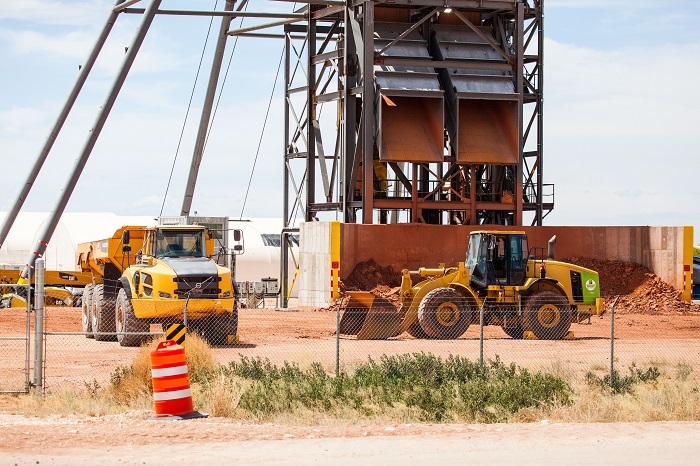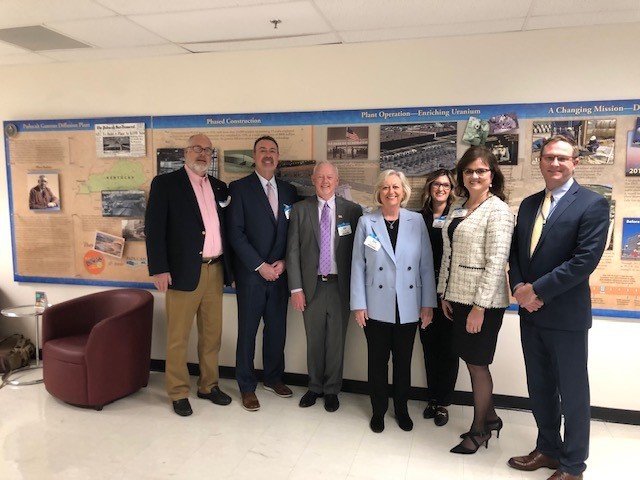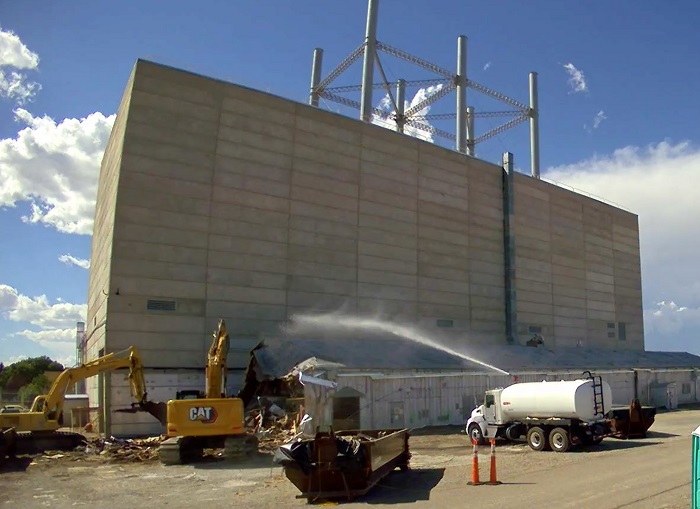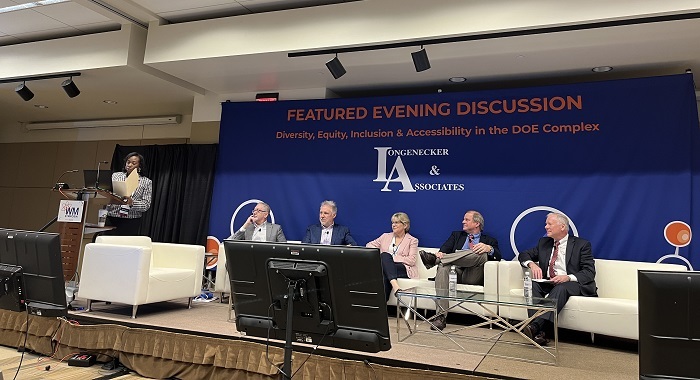 A three-tiered work stage known as the Galloway is lowered into the utility shaft at EM's Waste Isolation Pilot Plant.
CARLSBAD, N.M. – Progress continues on a new utility shaft at EM’s Waste Isolation Pilot Plant (WIPP) as shaft-sinking crews recently surpassed the midway point at 1,076 feet deep.
“The utility shaft, or Shaft No. 5, is of great importance to WIPP and our ability to continue the Department’s critical national mission of safely disposing of defense transuranic waste,” said Acting Carlsbad Field Office Manager Mark Bollinger. “When completed, this shaft will be part of the new permanent ventilation system that will allow us to provide critical airflow to the underground workforce.”
 Debris from shaft-sinking activities is loaded into a dump truck at EM’s Waste Isolation Pilot Plant. The chutes shown in the background carry debris out of the utility shaft being constructed and dumps it on a concrete pad where it’s scooped up by a front-end loader.
When complete, the full shaft depth will be 2,275 feet, with the team now halfway to the WIPP repository depth of 2,150 feet.
Workers completed construction of concrete liner in the shaft to a depth of 873 feet in January. The team is currently performing shaft excavation activities of drilling, blasting, rubble removal, geological mapping and installation of ground support. These activities will be repeated until the station depth is reached at 2,150 feet.
The new shaft and a permanent ventilation system known as the Safety Significant Confinement Ventilation System are part of a capital investment in upgrading WIPP’s infrastructure so the facility can operate safely and compliantly for decades to come. When finished, that system will triple the airflow to the WIPP underground from the current 170,000 cubic feet per minute (cfm) of filtered ventilation to as much as 540,000 cfm.
“It’s exciting to see the progress that is being made,” said Ken Harrawood, program manager for Salado Isolation Mining Constructors (SIMCO), WIPP’s management and operations contractor. “It cannot be understated, the importance of the work that is being done to complete the utility shaft. I can’t say enough about how well our subcontractor is performing.”
Blasting and excavation occurs around the clock. Workers drill holes and set explosive charges in half of the shaft circle. Rubble from the subsequent explosion is scooped by remote-controlled mechanical clamshells on the bottom of a cylindrical three-deck work stage known as the Galloway that hangs in the shaft. The mechanical clamshells dump the rubble into buckets raised through bucket wells in the Galloway to the surface. The rubble is dumped into chutes and onto a concrete pad where a front-end loader scoops it into a waiting truck to be hauled away.
Shaft-sinking is set to be finished by the end of this year. When complete, the new utility shaft will be WIPP’s largest shaft at 26 feet in diameter, with two 3,000-foot drifts being excavated at the 2,150-foot level to align with the rest of the WIPP underground.
-Contributor: Roy Neese
 WASHINGTON, D.C. – Leaders from the Paducah, Kentucky community met with senior EM officials Jeff Avery and Randy Hendrickson last week to discuss future reuse of EM’s Paducah Site. Standing in front of a permanent Paducah Site exhibit in the DOE headquarters James Forrestal Building from left: Craig Clymer, judge-executive, McCracken County Fiscal Court; Bruce Wilcox, president/CEO, Greater Paducah Economic Development; George Bray, mayor, City of Paducah; Sandra Wilson, president/CEO, Paducah Area Chamber of Commerce, and commissioner, City of Paducah; Jessica Newman, benefits administrator, Paducah Site contractor Swift & Staley; Myrna Redfield, president/CEO, Paducah Site contractor Four Rivers Nuclear Partnership (FRNP); and Cory Hicks, business services director, FRNP.
 EM decontamination and decommissioning crews work to remove two buildings at the Naval Reactors Facility at the Idaho National Laboratory Site last year. Watch a video on the project here.
IDAHO FALLS, Idaho – EM is moving forward with plans to demolish two defueled naval reactor prototypes and associated buildings at the Idaho National Laboratory (INL) Site.
EM, the Office of Naval Reactors Idaho Branch Office, the U.S. Environmental Protection Agency and State of Idaho Department of Environmental Quality agreed to an end state for the reactors and structures early last month.
The agencies had considered four alternatives ranging from no action, continued monitoring, partial demolition, to full demolition of the Submarine 1st Generation Westinghouse (S1W) and Aircraft Carrier 1st Generation Westinghouse (A1W) defueled naval nuclear propulsion plants and associated buildings at the Naval Reactors Facility at the INL Site.
After considering public comments, the agencies opted to remove the prototype facilities, which involves the removal of the reactor vessels and associated equipment and demolition of associated buildings to three feet below grade, with a majority of the waste to be disposed of at authorized facilities on the INL Site.
“Our crews look forward to this project,” said Mike Swartz, director of decontamination and decommissioning at Idaho Environmental Coalition (IEC), EM’s cleanup contractor at the INL Site. “This will be the largest demolition effort onsite in over a decade.”
S1W was the first land-based nuclear submarine prototype, developed concurrently with construction of the first naval nuclear submarine at Electric Boat in Connecticut. S1W became an important training facility for U.S. Navy nuclear operators.
As the Navy’s need for nuclear-powered surface ships evolved, the A1W nuclear prototype was built at the Naval Reactors Facility to test new technology.
The S1W and A1W facilities were shut down in 1989 and 1994, respectively. Both S1W and A1W prototypes are historically significant, and Naval Reactors has been working with the State Historic Preservation Office to preserve the history in accordance with the National Historic Preservation Act.
Under the chosen alternative to remove the facilities, low-level radioactive debris — including the reactor vessels and associated equipment — will be shipped to an authorized disposal facility such as the onsite Idaho CERCLA Disposal Facility. That 390,000-cubic-meter disposal facility provides a centralized engineered facility for containment of onsite waste for long-term protection of human health and the environment. CERCLA stands for the Comprehensive Environmental Response, Compensation and Liability Act.
Non-contaminated, non-hazardous debris will also be disposed of onsite. Demolition materials will be recycled to the extent practicable.
“Decommissioning these prototype facilities will have its own unique challenges,” IEC Waste and Decontamination and Decommissioning Senior Director Dan Coyne said. “We understand and respect the significance these facilities played in our country’s past, and we look forward to the opportunity of safely dispositioning them.”
-Contributor: Erik Simpson
 Oak Ridge hosted a panel at the 2023 Waste Management Symposia titled, “U.S. DOE Environmental Cleanup in Oak Ridge, TN: A New Chapter.” Participants from left include Oak Ridge Office of Environmental Management Manager Jay Mullis, UCOR President and CEO Ken Rueter, Isotek Project Manager Sarah Schaffer, Oak Ridge National Laboratory Site Office Manager Johnny Moore and Tennessee Department of Environment and Conservation Senior Advisor Patrick Flood.
PHOENIX – With numerous programs, contractors and regulators involved in the Oak Ridge cleanup mission, the site hosted a panel at the recent 2023 Waste Management Symposia highlighting how all of the organizations work together to enable progress.
Panelists shared information on projects since last year’s Waste Management conference, detailed what’s next on the Oak Ridge Reservation and explored critical milestones ahead. They also provided a full representation of the partners responsible for recent successes and plans for future achievements. The panel was titled “U.S. DOE Environmental Cleanup in Oak Ridge, TN: A New Chapter.”
Read special EM Update coverage of the 2023 Waste Management Symposia here and here.
Participants included Jay Mullis, manager of the Oak Ridge Office of Environmental Management (OREM); Ken Rueter, president and CEO of cleanup contractor UCOR; Sarah Schaffer, Isotek project manager; Johnny Moore, Oak Ridge National Laboratory (ORNL) site office manager; Glen Adams, supervisory toxicologist with the U.S. Environmental Protection Agency Region 4; and Patrick Flood, senior advisor for the Tennessee Department of Environment and Conservation.
“The main strategic vision for Oak Ridge is to reduce risks and deliver results,” Mullis said.
Speakers spotlighted how OREM and its partners are working together to transform ORNL. It involves UCOR deactivating and demolishing scores of old former reactors and isotope labs in the coming years. Progress is already underway on that front, and it’s visible.
UCOR crews recently completed the first demolition of a former reactor in ORNL’s central campus area. They tore down the Bulk Shielding Reactor, which dates back to the 1950s and has been shut down since 1991. This project is the first of many that will eliminate risks and open land for future research missions at the site.
“We’ve accomplished a lot,” Rueter said, adding that UCOR looks forward to future success as workers reduce risks and help facilitate their missions.
Crews are weeks away from starting demolition on the Low Intensity Test Reactor, which is adjacent to the site of the former Bulk Shielding Reactor.
Isotek, another OREM contractor, is working on the highest cleanup priority at ORNL. It is responsible for eliminating the inventory of uranium-233 stored at the site. That material is stored in the oldest operating nuclear facility in the world, requiring significant resources annually from DOE to keep it safe and secure.
Schaffer discussed the U-233 Disposition Project, detailing Isotek’s processing campaign that allows downblended material to be solidified and shipped for disposition.
Processing and dispositioning of the U-233 inventory will reduce costs to taxpayers, provide rare medical isotopes to advance next-generation cancer treatment research and allow OREM to demolish large old facilities in the heart of ORNL to make room for new facilities and missions.
OREM’s cleanup is directly benefiting the future of ORNL. Site Office Manager Johnny Moore discussed how the cleanup mission is enabling the science mission there. He provided information on the site’s various science and technology initiatives that are making ORNL a world leader in numerous fields. He also detailed how working collaboratively with the cleanup contractors is helping make the site safer and freeing up valuable real estate for future operations.
Regulators are another crucial element of the cleanup mission.
Adams and Flood discussed the importance of the regulatory partnership framework with OREM and highlighted how it supported the decision-making process that led to the approval of the record of decision for the site’s Environmental Management Disposal Facility.
-Contributor: Chris Caldwell
|